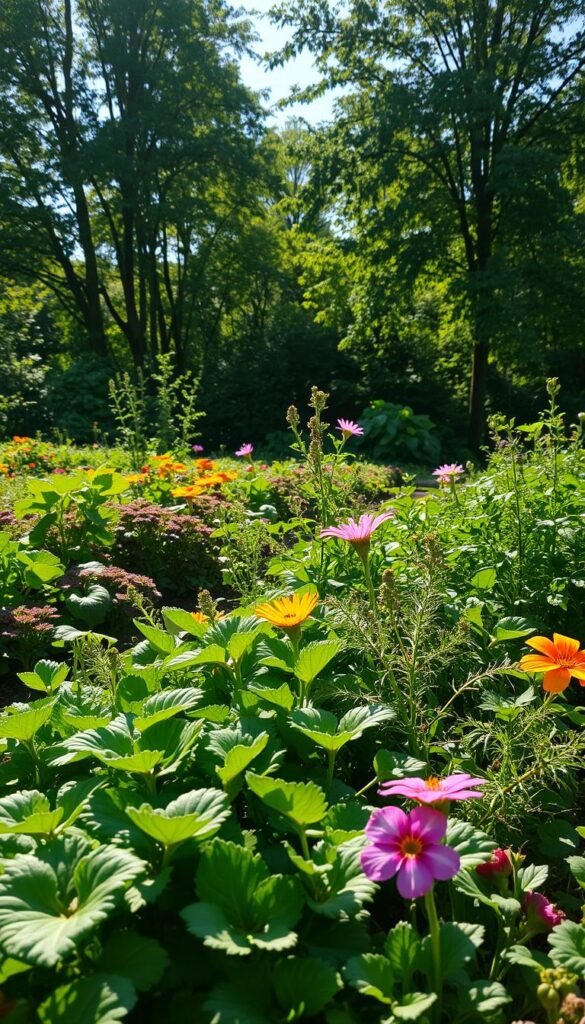Want a healthier, more productive garden without extra chemicals? Companion planting is an easy way to help your plants thrive naturally. By pairing certain species together, you can boost growth, deter pests, and make the most of your space.
This method has been used for centuries, with science backing its benefits. For example, basil improves tomato flavor while repelling insects. Beans add nitrogen to the soil, helping nearby peppers grow stronger. Even flowers like marigolds protect vegetables from harmful bugs.
Whether you’re growing in containers or garden beds, strategic pairings simplify care. You’ll spend less time battling pests and more time enjoying fresh harvests.
Ready to try it? Start with proven combos like the Three Sisters (corn, beans, and squash) or herbs that mask vulnerable plants’ scents. Small changes can make a big difference in your garden’s success.
What Is Companion Planting? (And Why It’s a Game-Changer)
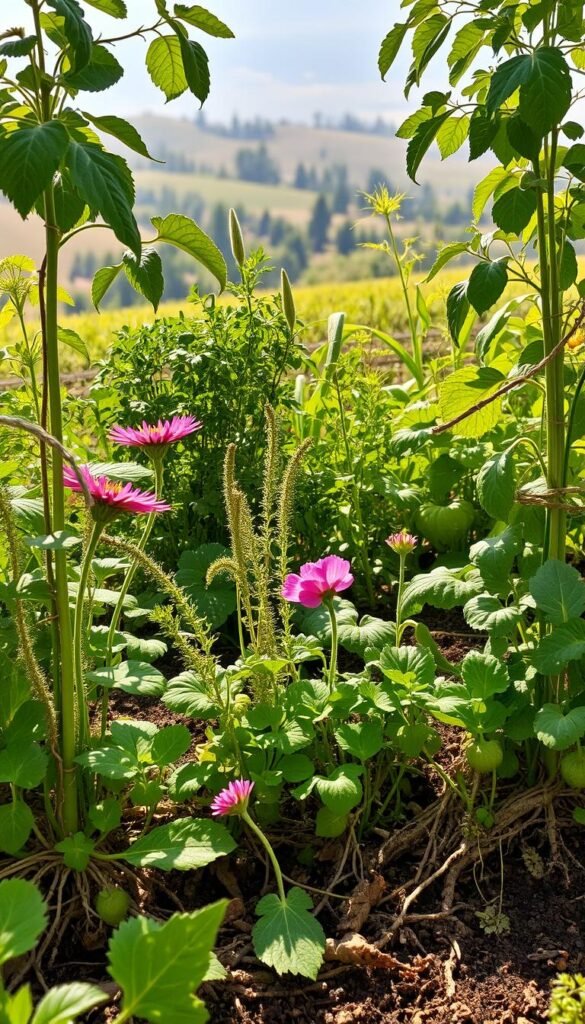
Nature has its own way of helping plants grow better together. This ancient practice, called companion planting, pairs species that support each other’s growth. Think of it as teamwork underground and above the soil.
Nature’s teamwork: How plants help each other
Some plants repel pests with their scent, like marigolds deterring nematodes. Others provide shade or improve soil health. Legumes, such as beans, pull nitrogen from the air into the soil, feeding nearby crops.
Diverse root systems also prevent soil depletion. Shallow roots (like lettuce) coexist with deep-rooted carrots, maximizing space and nutrients.
The Three Sisters method: A time-tested example
Indigenous communities perfected this trio: corn, beans, and squash. Corn stalks act as trellises for beans, which enrich the soil. Squash leaves shade the ground, suppressing weeds.
| Plant | Role | Benefit |
|---|---|---|
| Corn | Support | Provides structure for beans |
| Beans | Nitrogen fixer | Boosts soil fertility |
| Squash | Ground cover | Blocks weeds, retains moisture |
Modern gardeners adapt these principles too. Sunflowers support climbing cucumbers, while basil enhances tomatoes’ flavor and pest resistance.
7 Benefits of Companion Planting for Your Garden
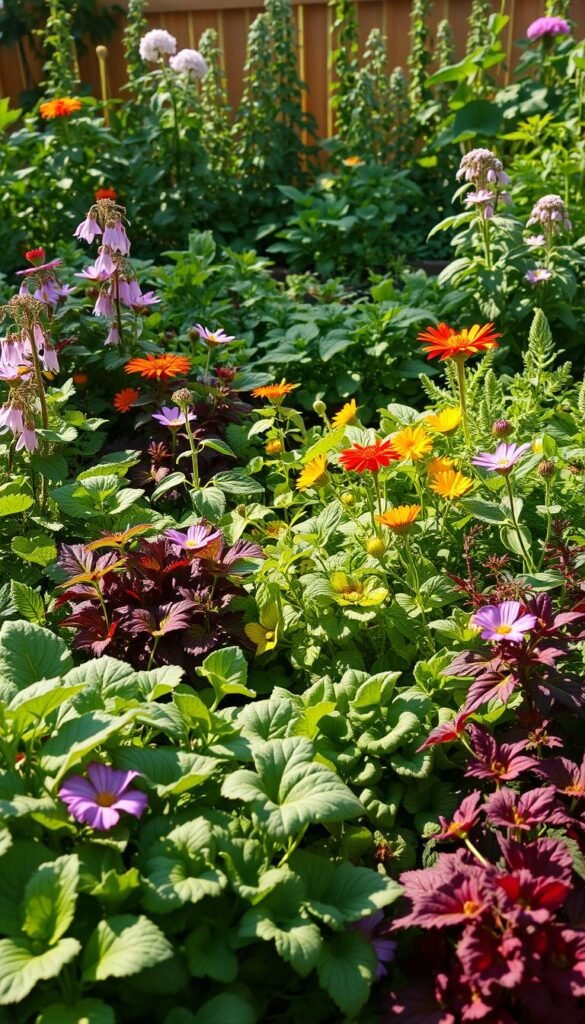
Boost your harvests while keeping bugs at bay with smart plant partnerships. This method taps into nature’s balance, offering perks from fewer chemicals to tastier veggies. Here’s how it works:
Natural pest control without chemicals
Some plants are nature’s bodyguards. Marigolds release a scent that repels root-knot nematodes, while basil masks tomatoes’ aroma, confusing hornworm moths. Nasturtiums act as sacrificial plants, luring caterpillars away from cabbage.
For potatoes, planting garlic nearby cuts aphid infestations. Buckwheat attracts ladybugs—a natural predator for corn pests. These pairings reduce reliance on sprays, keeping your food safer.
Boosting pollination and crop yields
Flowers like zinnias and borage are pollinator magnets. Bees flock to them, increasing visits to squash and cucumber blossoms. More pollination means plumper produce.
Borage also invites parasitic wasps that target tomato pests. The result? Up to 30% higher yields, according to studies.
Improving soil nutrients and structure
Deep-rooted plants like burdock pull up minerals, sharing them with shallow-rooted neighbors. Beans fix nitrogen, enriching the earth for heavy feeders like corn.
French marigolds, when tilled into soil, suppress harmful nematodes while adding organic matter. Healthier dirt means stronger plants—and less fertilizing for you.
- Space efficiency: Pair quick growers (radishes) with slow ones (carrots).
- Weed suppression: Squash leaves shade soil, blocking weeds naturally.
- Flavor boost: Basil near tomatoes enhances their taste.
Easy Companion Planting Pairings for Beginners
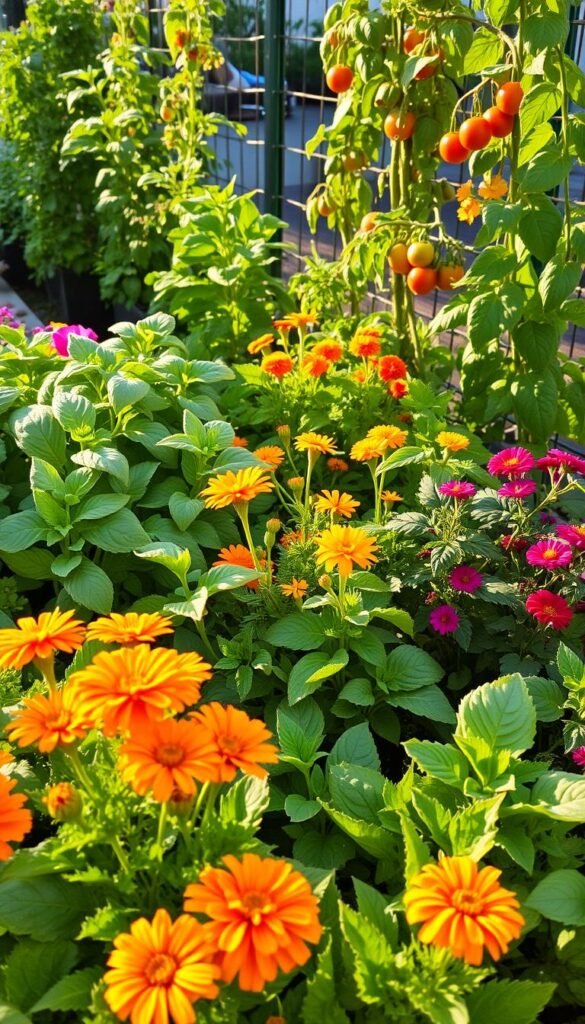
Some plants just work better together—discover the easiest pairings for a thriving garden. These combos tackle pests, boost flavor, and save space with minimal effort. Start with these proven matches to see quick results.
Tomatoes + Basil: The Dynamic Duo
Basil isn’t just for pasta—it’s a powerhouse partner for tomatoes. Its scent masks the tomatoes’ aroma, confusing pests like whiteflies. Plus, studies show basil enhances tomato flavor.
Plant them side by side in containers or beds. Bonus: basil’s shallow roots won’t compete with tomato roots for nutrients.
Corn, Beans, and Squash: The Ultimate Trio
This ancient trio (the Three Sisters) is a masterclass in teamwork. Corn stalks support climbing beans, which enrich the soil with nitrogen. Squash leaves shade the ground, blocking weeds.
Plant corn first, then beans once stalks are 6 inches tall. Add squash seedlings a week later for seamless synergy.
Flowers That Protect Veggies
Marigolds and nasturtiums are garden bodyguards. Marigolds repel root-knot nematodes, while nasturtiums lure aphids away from broccoli and cabbage.
- Edge beds with marigolds or interplant with tomatoes.
- Let nasturtiums sprawl near brassicas as a sacrificial crop.
- Add chives near lettuce to deter rabbits naturally.
The Science Behind Successful Plant Partnerships

Ever wonder why certain plants thrive together while others struggle? It’s not magic—it’s biology. Research shows how scent, root systems, and chemistry create natural alliances that boost growth and fend off threats.
How Scent and Root Systems Create Harmony
Plants communicate through chemicals. Basil releases volatile oils that mask tomatoes’ scent, confusing pests like hornworms. Meanwhile, garlic’s sulfur compounds repel Colorado potato beetles—a trick proven in studies.
Root depth matters too. Shallow-rooted spinach pairs perfectly with deep-rooted tomatoes, sharing nutrients without competition. In square-foot gardens, this maximizes space and yield.
Research-Backed Pairings That Deliver Results
Science validates these duos:
- Garlic + potatoes: Cuts aphid infestations by 50% (University of Nebraska).
- Thyme + brassicas: Reduces armyworm eggs by 60% (Iowa State).
- Marigolds + tomatoes: Roots deter nematodes while blooms attract pollinators.
Even tansy’s glucosinolates protect fruit trees from codling moths. These partnerships aren’t guesses—they’re green-thumbed science.
Companion Planting Mistakes to Avoid
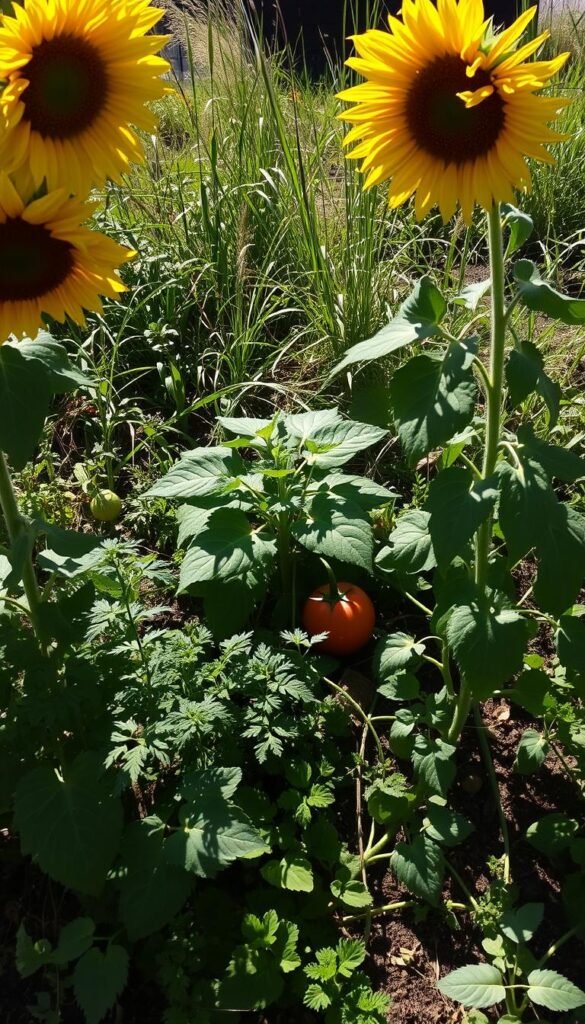
Even the best garden plans can go wrong if you overlook these common pitfalls. While strategic pairings boost growth, some errors can stunt plants or invite pests. Here’s how to sidestep trouble and keep your garden thriving.
Overcrowding: Give Plants Room to Breathe
Too many plants in one space compete for light and nutrients. For example, squash vines can smother nearby herbs if not spaced properly. Follow seed packet guidelines—usually 12–24 inches apart for most veggies.
Tall crops like corn should face north to avoid shading shorter neighbors. This prevents “shade wars” that slow growth.
Mismatched Growth Rates and Habits
Pairing fast and slow growers risks one overtaking the other. Mint spreads aggressively, choking delicate lettuce if not containerized. Similarly, potatoes’ deep root systems can damage bush beans during harvest.
Stick to these rules:
- Separate invasive herbs (like mint) from mild greens.
- Rotate crops yearly to prevent soil nutrient depletion.
- Avoid allelopathic pairs—black walnuts release toxins that harm tomatoes.
With a little time and planning, your companion planting efforts will pay off. Remember: balance is key to a healthy, productive garden.
Maximizing Small Spaces with Strategic Pairings
Small gardens can produce big harvests with the right plant partnerships. By matching shallow and deep-rooted plants, you’ll use space efficiently and boost yields. Quick-growing crops fill gaps while slower varieties mature, saving time and effort.
Shallow vs. Deep-Rooted Plant Combos
Pair spinach with corn—the tall stalks provide shade for tender greens. Meanwhile, shallow-rooted lettuce thrives beside deep-rooted carrots. Both share soil without competing for nutrients.
Green onions are perfect fillers between lettuce heads. Their small root systems won’t disrupt growth, and they deter pests naturally.
Quick-Growing Crops Between Slow Growers
Radishes mature in 30 days, making them ideal neighbors for slow Brussels sprouts. Harvest them before sprouts need more room. Try these time-saving tricks:
- Vertical space: Train peas up sunflower stalks for double-duty planting.
- Shade-tolerant greens: Grow arugula under tomato cages.
- Herbs for pest control: Tuck cilantro between tomato rows.
Layer plantings by sowing carrots after harvesting quick-turn spinach. This keeps soil active and maximizes every inch.
Your Next Steps: Start Planting Smarter Today
Ready to transform your garden with nature’s teamwork? Begin with easy wins like basil and tomatoes or marigolds with squash. These pairs offer quick results while you learn the ropes.
Use tools like the Almanac Garden Planner to find science-backed matches. Track your progress in a journal—note which plants thrive together and which don’t. Small adjustments save time and boost yields.
Focus on these starters:
- Edge beds with marigolds to shield tomatoes from pests.
- Plant beans near corn for natural nutrients.
- Tuck herbs like chives between lettuce rows.
Healthy soil and smart pairings make all the difference. Join gardening forums to swap tips and celebrate successes. Your thriving oasis awaits!

